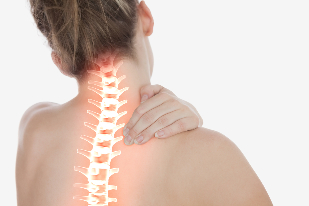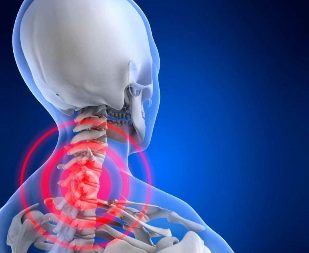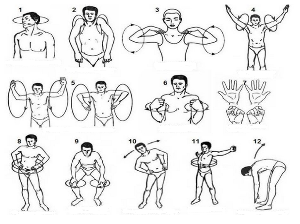Right now it Is only found of the manifestations of this widespread disease: according to statistics, about 60% of the population in the developed countries, in varying degrees, suffer from the manifestations of osteochondrosis. The main reason for such a wide distribution, sedentary jobs, the lack of motion of the modern man.

Osteochondrosis of the cervical spine (Osteohondroz) is a degenerative-dystrophic lesions of the intervertebral discs, which is the same damaged discs, the vertebrae in the joints of the cervical, decrease of height of intervertebral discs. The disease is progressing, if it is not treated in the to cause headaches, circulatory problems in the even of a hernia. Such as osteoporosis, a disease that occurs due to a disorder of the metabolism of the minerals, which causes the bones in the joints, become less severe.
Osteochondrosis can lead to instability of the cervical spine (the symptoms of the treatment as similar to the chondrosis, but also have a number of features, which is often accompanied by a displacement of the vertebrae. To promote the development of a degenerative disease of the disk, destroying the backbone of the Department.
Osteochondrosis of the cervical spine: the symptoms of
The early stages of the disease, In almost the share the only way to suffer from the painful symptoms, you may feel pain in the neck after a big physical exertion or prolonged sitting taut in position by a sudden movement of the bend or the head.
The main symptoms are – headache, dizziness, in the hard-of-hearing co-ordination, a light crunch when you move your head, weakness; less commonly observed weakness of arm, numbness of the tongue, in slurring of speech, difficulty with breathing, vision, hearing, sweating, abnormally high blood pressure. The main areas of the head, the neck, the collar, the belt. In the majority of cases, at the same time, there are only a few of the above mentioned symptoms.
In General, the symptoms of of osteoarthritis is not obvious, and often mask the use of drugs to relieve pain. It's one of the hazards of most of the symptoms in other diseases, making the diagnosis of cervical degenerative disc disease.
Dizziness with cervical osteochondrosis
However, this condition is not always clear to preach to the degenerative disc diseases of the cervical spine.
The monsters in the land, so that it may be the result of:
- inflammation of the middle or inner ear;
- spasm of cerebral vessels;
- violations transmission of nerve impulses;
- problems with the vestibular apparatus;
- diseases of the heart, in the circulatory system.
There is no clear-cut criteria, and dizziness osteochondrosis. There are, however, a systemic non-systemic dizziness, they're both different variations.
It is recommended that you know the difference between a systemic non-systemic dizziness, to help you to find out the causes of strange State:
- the system of dizziness, is a feeling of a circular motion of the surrounding objects or to the body, which is a consequence of the disruption of apparatus, vestibular, visual analyzers of the receptors in the joints, the muscles in the epidermis (lower back pain, of various etiologies);
- the non-systemic dizziness, is a feeling of faintness, a feeling of stunned, you know, the state is in the vertical position. When a non-systemic dizziness, feeling of circular rotation is lacking in a significant difference in the comparison of the sign.
The people who consider the temple, one of the species is to be monitored by an experienced physician, in particular, or a neurologist, if there is a suspicion on disease of the ear in the emerging music groups) by an otolaryngologist.
The reason for the emergency in-hospital treatment, not related to degenerative disc diseases of the cervical spine, is the identification of the patient (except for the vertigo), take the signature, like this:
- the facial paralysis of the numbness of the shoulder belt;
- severe headache, on the grounds of health;
- violation of coordination of movements;
- the loss of, or loss of consciousness.
Headache in cervical osteochondrosis
It is one of the most common non-specific sign of many diseases. Headaches characterized by a particularly for the female population. It is difficult to determine the cause of the headaches, in addition to this, it is combined with injuries of the spinal column. There are about 14 different reasons for headache in human beings.
Best would be a common cause of headaches is described by the pathology:
- spasm of cerebral vessels;
- a pinched nerve roots;
- a reflex increase in intracranial pressure.
Headache in cervical osteochondrosis, can you recall the feeling when, hypertension, angina pectoris, or stroke. Especially in middle-to older people, they tend to have a risk of developing a stroke or a heart attack.
The sensation of pain may be paroxysmal, constant, throbbing, the dull.
When heart disease, they complain of the patients in the chest pain accompanied by a disorder of the rhythm of the heart. For the determination of the cause only by a qualified physician. In the case of headaches combined with nausea and dizziness in a pain in your chest, for the care of the ECG.
Pain in the cervical osteochondrosis
Don't always be the pain is localized in the head, in the neck. Are known a variety of cases, the localization of the pain.
The pain in the neck to the submission of the area of the shoulder, in the different parts of the hand. A special feature of such feelings in the event of a sudden attacks after sleep, a sudden movement, invisible to the human stress, for example when you laugh or sneeze. The pain associated with degenerative disc disease, if it is not the procedure adopted by the long-lasting nature usually passes after a short period of time in combination with the crunch of the cervical vertebrae.
None of the previous research should not only be a pain to remove with the use of manual therapy (massage). In some cases, inept to dismiss the manipulation may worsen the pathology, disrupt the innervation of cause, or the disability of the patient.
The intensity of the pain be mild or it can be sharp. For the duration of the – so long, in a short time.
If it is seen, that the cervical osteochondrosis most often associated with damage to the sixth to the seventh cervical vertebra.
The texts are available for the determination of the localization of the pain impulse. The defeat of is in the region of the sixth vertebra is coupled with pain in the thumb, but a defeat in the region of the seventh vertebra is accompanied by pain in the middle-earth.
The blood pressure of the cervical osteochondrosis
The relationship of cervical degenerative disc disease with irregular blood pressure has long been established. The cervical vertebra is so important to the nerve endings in the blood vessels.
The characteristic changes in the pressure of the day. High blood pressure for a long period of time is not a characteristic of the disease. The Reflex irritation of the nerve endings in the short-term spasms of the blood vessels causing an abrupt diurnal dynamics of arterial hypertension.
A distinctive feature of the increased pressure in the cervical osteochondrosis of the neck is to see a combination of the following symptoms:
- headaches;
- the pains in the limbs, in the chest;
- to reduce the sensitivity of the neck area;
- the occurrence of the pressure peak after stress, muscle tension, prolonged stay in an uncomfortable position, in a similar situation.
The tip of the HELL of a rapid deterioration in health, as a basis for a finding of emergency medical care.
At the stage of development of osteochondrosis
In the development of degenerative changes, cervical disc disease, it is decided that a 4-stage process. But that's pretty much conditional on a division, the majority of the symptoms, as the disease may occur in other diseases.
In the first stage (pre-clinical)
In the early stages, as symptoms are mild as are often attributed to stress or other illness. The feeling is bad, the stiffness in the neck, pain of the sharp movements or tilts. At this stage, it is possible to get rid of the nascent degenerative disc disease through the use of therapeutic exercise moving, or more, to adjust the power.
The second phase of the
The pain increased to become constant, while the sharp turns on the slopes, or way too strong. Occur in the severe headaches, the patient begins to tire, become distracted, from time to time to numb the area of the face.
The third phase of the
A disc herniation can often cause dizziness, weakness in arms, pain in neck and arms, still feeling his shoulders.
The fourth stage of the
In the end, the intervertebral discs, thus, will be destroyed, so that it is replaced by connective tissue. Zaselyalsya of the nerves, which causes difficulty in movement, severe pain, increased dizziness, noise in the ears.
The causes of the risk factors
Oddly enough, the possibility of the development of the osteoarthritis of the human beings as a result of one of their evolutionary advantages of an upright posture: the vertebrae of the press, of the drug to the other, and in the age of the connective tissue to break down. The result of this is that it is more nearly a process. However, there are a lot of factors that can contribute to the earlier to the more intensive development of osteochondrosis:
- In the first place – that is, sitting in a sedentary way of life, observed in a contemporary, often the life of the (office workers, drivers, in other sedentary profession, with TV, long hours on the computer), and lack of physical activity.
- The intense, unnatural position in the process of, for example, by a computer, the person often leans forward to take the pressure representing the
- On the contrary the reason is, unusually for such a person for the load; however, in an emergency – also trained athletes, such as weightlifters;
- No, for the reason that it violates the natural posture of a man: the uncomfortable shoes, especially high heels, and poor posture while sleeping, flat feet, arthritis, scoliosis;
- Excessive weight gain, which often is a result of malnutrition
- Frequent stress, severe stress, constant fatigue
- Local hypothermia
How is it dangerous to the cervical osteochondrosis
In the neck there are a lot of parts of the blood vessels, the arteries, the capillaries, in a possible violation, therefore, they may be there to be unpleasant consequences, including hypoxia, hypertension, vascular dystonia.

The cervical degenerative disc the impact of the disease of the spinal segment that controls the operation of the shoulders, the elbow joints, the thyroid, the hands of the other organs. In osteochondrosis, if it is not treated, it is likely, pinched nerves, compressed blood vessels, which results in a work necessarily of the other organs.
How to treat a cervical osteochondrosis
He says the stable of success in the treatment of degenerative cervical disc disease, can only be achieved through an integrated approach that includes medication, massage of the neck, therapeutic gymnastics, physiotherapy. In advanced cases, it is very easy to require a surgical procedure.
It is strongly recommended that you should not only resort to medical treatment, in particular due to the fact that the symptoms of lower back pain, it can mean a totally different illnesses in addition to the fact that your chosen medication will help you heal, you may still be able to cause damage.
The withdrawal of acute pain
Osteochondrosis, particularly in the later stages, which is accompanied by severe pain, and is therefore the first task of the physician is to your ease, the suffering. He will prescribe painkillers, anti-inflammatory agents, vitamins, chondroprotectors to restore cartilage tissue, medications to improve the blood circulation in the decrease of spasm of the muscles of the.
Therapeutic exercises with cervical osteochondrosis
The in the available, including the house of the method – a physiotherapy. While it is also very effective, as it strengthens the muscles of the neck restoring the flow of blood to the damaged areas, to compensate for the lack of exercise in our daily lives. Physical therapy can be supplemented with swimming, Aqua-gym.
Physiotherapy is the ideal in a cost effective form of cervical degenerative treatment of diseases of the disk, at the same time, a very safe and effective. The treatment of the exercise is to be done at home. In osteochondrosis of the intensity of the workout is not critical, only the frequency changes. In the first place, the weight training to strengthen the muscles of the neck, to make up for the lack of function of the spinal column to help support the weakened vertebrae.

To strengthen the muscles of the neck, as recommended in activities of daily living. This can be very simple, consisting of rotation of the head may tilt in a variety of ways, in a more and more complex, including the use of the neck muscles from time to time. Thus, it can Be performed at home, in the workplace. For example, if the work is sedentary, it can be helpful to do these exercises after an hour of sitting at the dinner Table, or a display monitor.
Physical therapy, physical therapy
The proper use of the consistent physical therapy, physical therapy techniques, which improve the blood circulation in the injured areas to reduce inflammation of the pain will slow down the process of ossification.
Osteochondrosis of the cervical, with the electrophoresis, magnetotherapy, laser therapy, shock wave therapy, medical bath, in the shower, mud therapy in different methods.
Massage the Neck with osteochondrosis of the cervical spine
Osteochondrosis of a massage can be very effective: it improves blood circulation, reduces spasms, decreases muscle tone, alleviates the symptoms of pain in the improve the General condition of the patient.
However, in the power of massage therapy, which is to be used with great caution, the inept resolved into a rude, as the impact on the patients parts of the body, it can only hurt.
The surgical treatment of
In cases of extremely advanced it is not even excluded in the operation: narrowing of the spinal column, herniation of intervertebral disks, spondylolisthesis, on the.
The decision on the need for the surgical method, by a surgeon, and he sets out the staging of activities, the duration of the postoperative period of the rehabilitation.






















